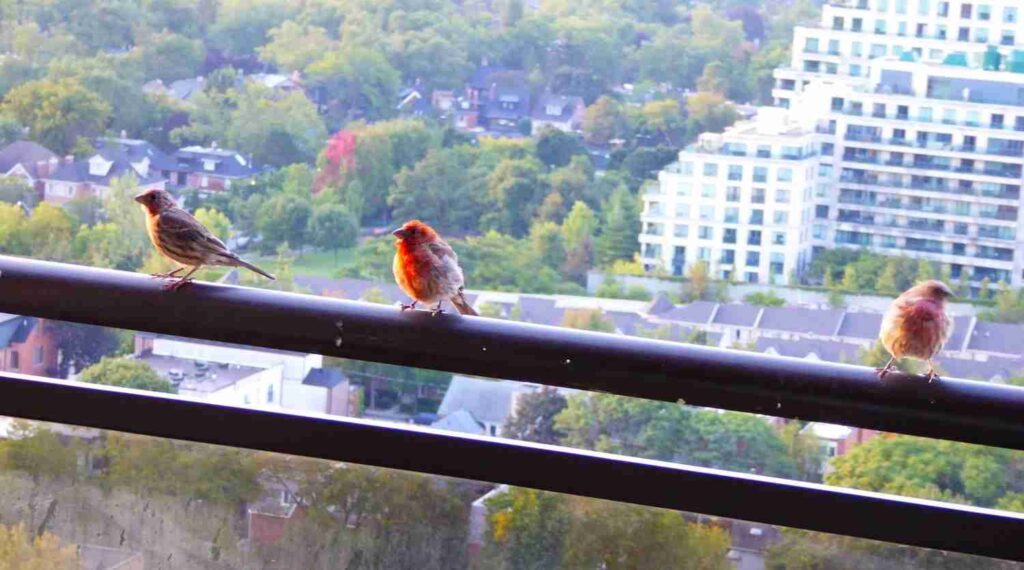Create a Bird-Friendly Sanctuary at Home by Transforming Your Balcony into a Haven

Create a Bird-Friendly Sanctuary at Home by Transforming Your Balcony into a Haven
In recent years, there has been a notable surge in the popularity of ‘bird gardens’ – miniature paradises of biodiversity nestled within urban settings. These spaces are designed to attract a diverse array of bird species by incorporating specific plants, food sources and shelter options.
30 April 2024
By Ishika Kumar
Amid bustling urban landscapes, the desire to reconnect with nature often feels like a distant dream. However, with a little ingenuity and effort, you can bring the wonders of the natural world right to your doorstep by transforming your balcony into a bird-friendly sanctuary. In this comprehensive guide, we’ll explore the essential steps and considerations for attracting birds to your balcony, thereby ensuring a harmonious coexistence between humans and wildlife.
Understanding the Trend: The Rise of Bird Gardens
In recent years, there has been a notable surge in the popularity of ‘bird gardens’ – miniature paradises of biodiversity nestled within urban settings. These spaces are designed to attract a diverse array of bird species by incorporating specific plants, food sources and shelter options.
By embracing the concept of a bird garden, you can not only enhance the aesthetic appeal of your balcony but also contribute to the overall conservation of local bird populations.
Essential Elements
The foundation of any bird-friendly balcony begins with the provision of essential resources: water and food. Birds require access to clean water for drinking and bathing, making a shallow birdbath or water dish a vital addition to your balcony space. Regularly replenishing the water ensures its freshness and appeal to visiting birds. Beautiful dishes can be made as part of the birdhouses or separately.
When it comes to food, offering a diverse selection ensures that you cater to the varied dietary preferences of different bird species. From chopped corn and fresh fruit to seeds and nuts, providing a buffet of options increases the likelihood of attracting a wide range of avian visitors. Placing the food sources strategically, away from potential predators like pigeons, ensures that smaller birds feel safe and welcome.
Some easily available foods are:
· Millets
· Mealworms; canned in the market.
· Oats
· Crushed Peanuts: unsalted or fresh only.
· Sunflower seeds
· Corn
Creating Safe Spaces
In addition to food and water, birds require shelter and nesting sites to feel secure in their surroundings. Incorporating birdhouses or nest boxes into your balcony design provides nesting opportunities for small bird species, encouraging them to establish a presence in your space. These shelters should be securely mounted and positioned to minimise the risk of predation, ensuring the safety of nesting birds and their offspring. These can be made with wood, clay and cement.
Artificial nests, whether purchased or DIY, offer another avenue for attracting breeding pairs to your balcony. By installing these nests prior to the spring mating season around March, you provide birds with a ready-made nesting option, increasing the likelihood of successful breeding and population growth in your area.
Planting for Birds
Plants play a crucial role in attracting birds to your balcony, providing not only food but also shelter and nesting materials. When selecting plant species for your bird-friendly garden, prioritise native varieties that are well-adapted to your local climate and soil conditions. Native plants not only support local biodiversity but also provide a familiar and reliable food source for native bird species with flowers and foliage. Colourful ribbons or non-toxic decorations of yellow, red and orange colours might help attract them significantly.
Choose plants with bird-friendly attributes such as colourful flowers, edible fruits and dense foliage that offer protection from predators and the elements. Consult with local botanical experts to identify plant species that are particularly attractive to birds and well-suited to your balcony’s microclimate. Here are a few to get you starting:
· Sunflowers
· Coneflowers
· Hibiscus
· Berry Shrubs
· Cotoneaster Genus Shrubs
· Ivy and Other Climbing Plants
· Lilies
· Flowering Vines
· Marigolds
· Zinnia
· Rose Hips
· Hawthorn
Trees like apple, medlar, and pear are aromatic plants that attract many insects for birds to feed on, as an additional advantage. Ones in India which are bird-friendly are:
· Neem Tree: The Common Myna and Yellow Vented Bulbul, among other birds, love to feed on its fruits.
· Lemon Tree: It is a favourite among insects and caterpillars, and hence birds come on this one for food for them and their young ones.
· Curry Leaf Tree: The Asian Koel and the Red-Vented Bulbul love the fruits of this tree.
· Jamun Tree: The birds love their fruits.
· Mango Tree: Loved by all birds, likewise.
· Gooseberry: Perfect for nesting as well as for its fruits.
Mitigating Risks
While creating a bird-friendly balcony, it’s essential to consider potential hazards that may pose risks to visiting birds.
Large glass surfaces, such as windows and glass railings, can be hazardous for birds, leading to collisions and injuries.
Solution
Installing anti-collision stickers or decals on these surfaces helps birds recognize the presence of obstacles and avoid collisions, reducing the risk of accidents. Additionally, minimising the presence of potential predators, such as cats or dogs, in your balcony space is crucial for ensuring the safety of visiting birds. Implementing measures to deter cats, such as installing barriers or motion-activated deterrents, helps create a safer environment for birds to feed, nest, and roost.
Patience and Persistence
Attracting birds to your balcony is a process that requires patience, persistence and ongoing maintenance. While some birds may discover your balcony oasis quickly, others may take time to recognize it as a safe and welcoming environment. By consistently providing essential resources, maintaining bird-friendly habitats and mitigating potential risks, you can gradually attract a diverse array of avian visitors to your balcony garden. The saying, “All good things, take time!” applies here.
In conclusion, transforming your balcony into a bird-friendly sanctuary is a rewarding endeavour that fosters a deeper connection with nature and contributes to the conservation of local bird populations. By following the steps outlined in this guide and embracing the principles of bird-friendly design, you can create a haven for birds to thrive amidst the urban landscape and soaring high temperatures of the summer heat.









